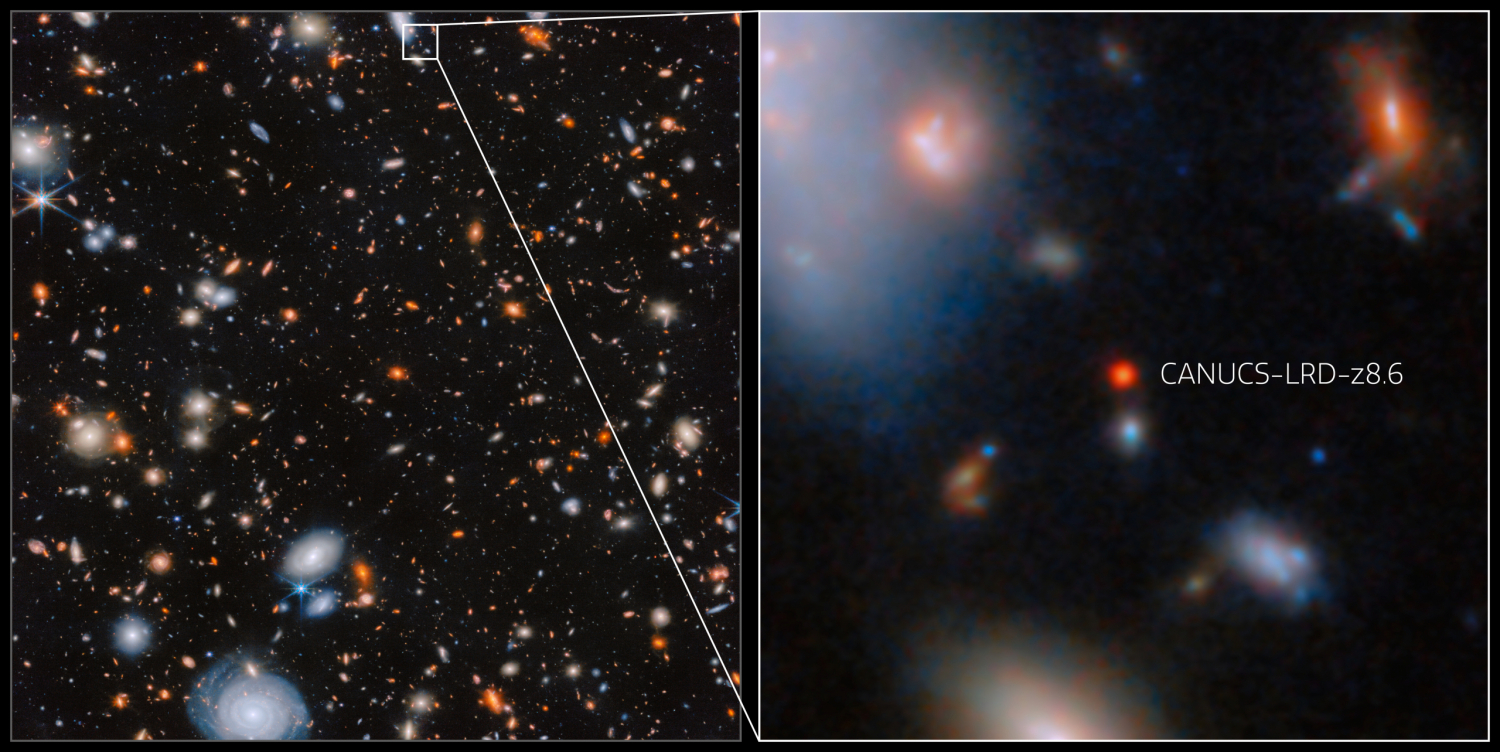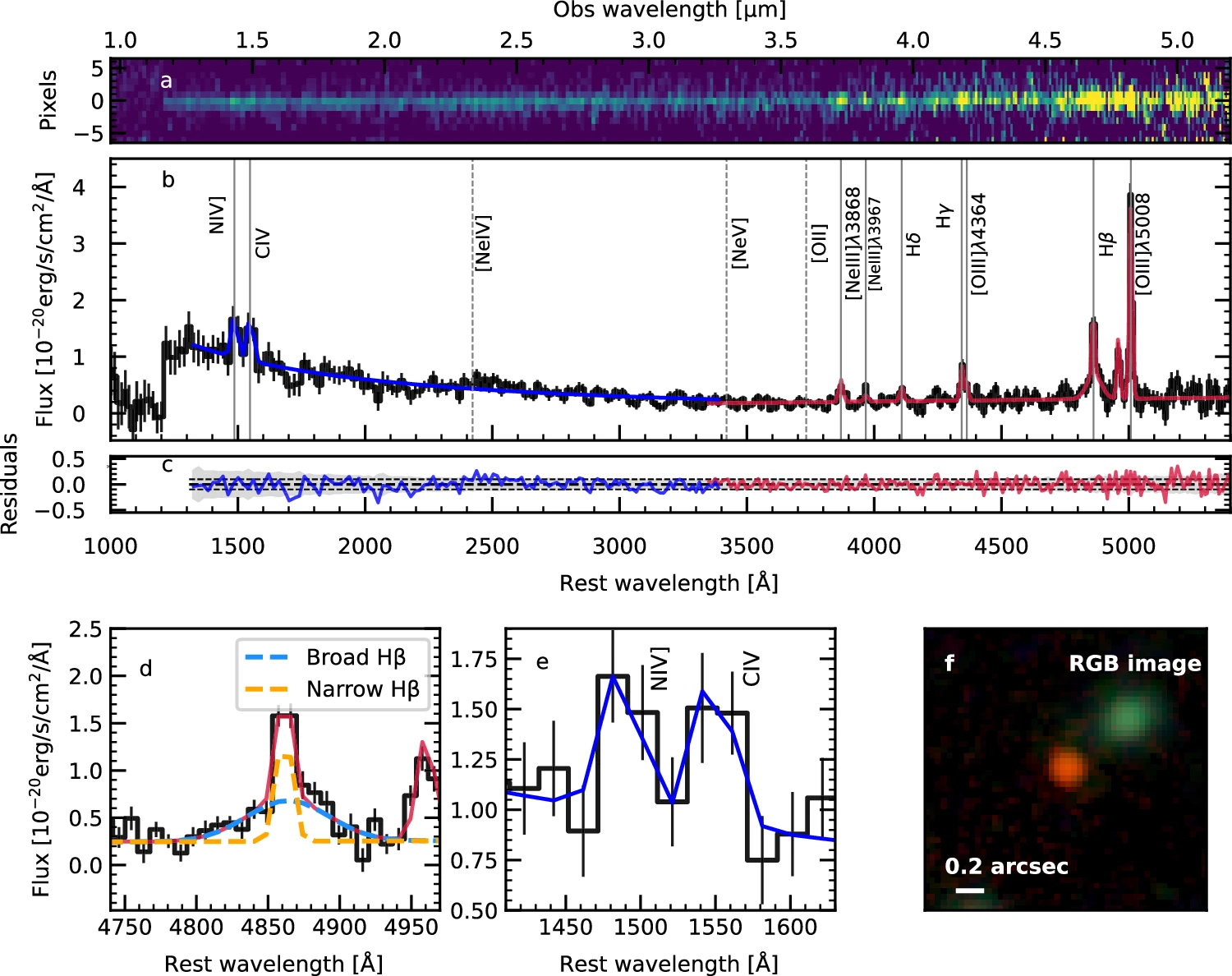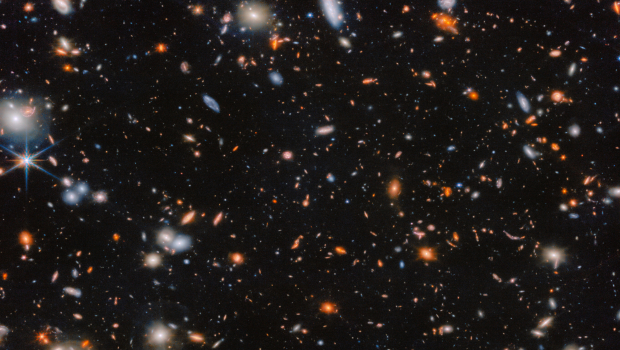9
Using the joint NASA/European Space Agency/Canadian Space Agency James Webb Space Telescope, a group of astronomers has discovered a supermassive black hole within the distant galaxy CANUCS-LRD-z8.6. The galaxy is among the farthest ever observed, with Webb imaging it as it was just 570 million years after the Big Bang.
CANUCS-LRD-z8.6 is a part of a unique class of galaxies that are extremely distant, small, and faint. The black hole discovered by Webb is actively growing and challenges current theories about the formation of galaxies, black holes, and other extreme cosmic objects in the very early universe.
Galaxies like CANUCS-LRD-z8.6 are often referred to as “little red dots” (LRDs) because their light is highly redshifted into the infrared portion of the electromagnetic spectrum due to their extreme distance from Earth. Since entering operation at the Sun-Earth Lagrange Point 2 (L2) in July 2022, Webb’s infrared sensitivity has helped astronomers discover dozens of LRDs across the universe.

The location of CANUCS-LRD-z8.6 within the MACS J1149.5+2223 galaxy cluster. (Credit: NASA/ESA/CSA/Webb/G. Rihtaršič (University of Ljubljana, FMF)/R. Tripodi (University of Ljubljana, FMF))
In the case of CANUCS-LRD-z8.6, Webb’s Near-Infrared Spectrograph (NIRSpec) instrument was used to observe the galaxy’s supermassive black hole. From the spectral information provided by NIRSpec, the astronomers, led by Roberta Tripodi of the University of Ljubljana FMF and the Rome Astronomical Observatory, found evidence for an accreting black hole.
See Also
“This discovery is truly remarkable. We’ve observed a galaxy from less than 600 million years after the Big Bang, and not only is it hosting a supermassive black hole, but the black hole is growing rapidly — far faster than we would expect in such a galaxy at this early time. This challenges our understanding of black hole and galaxy formation in the early Universe and opens up new avenues of research into how these objects came to be,” Tripodi explained.
CANUCS-LRD-z8.6’s spectrum showed highly ionized gas produced from energetic radiation. What’s more, the ionized gas appeared to be rotating at rapid speeds around the center of the galaxy — hinting at the presence of a supermassive black hole. After digging deeper into the NIRSpec data, the team was able to estimate the mass of the black hole.
This mass estimate revealed that the black hole was significantly larger than other, previously-discovered supermassive black holes from this early period of the universe. What’s more, the mass estimate showed that CANUCS-LRD-z8.6 had not yet produced many heavy elements and is still relatively compact, indicating that the galaxy was still in its very early stages of evolution.
The astronomers also analyzed other parts of the NIRSpec data, such as the energy emitted at different wavelengths, enabling them to characterize the physical properties of CANUCS-LRD-z8.6. Such properties include the mass of the galaxy’s stars and how they compare to the mass of the supermassive black hole.

The NIRSpec data from Webb on CANUCS-LRD-z8.6. (Credit: Tripodi et al.)
“The spectral features revealed by Webb provided clear signs of an accreting black hole at the center of the galaxy, something that could not have been observed with previous technology. What makes this even more compelling is that the galaxy’s black hole is overmassive compared to its stellar mass. This suggests that black holes in the early Universe may have grown much faster than the galaxies that host them,” explained co-author Dr. Nicolas Martis of the University of Ljubljana FMF.
It’s known that the mass of a supermassive black hole is related to that of its host galaxy. In most cases, a galaxy’s black hole will grow with the galaxy. However, CANUCS-LRD-z8.6 defies this — while the galaxy is among the most massive galaxies observed during this period of the universe, its black hole is even more massive than expected.
The team suggests that black holes may have formed and immediately begun growing at unprecedented rates in the early universe — outpacing their host galaxies. Such a phenomenon would explain why CANUCS-LRD-z8.6’s black hole is unusually massive compared to its galaxy.

The team’s hypothesized physical configuration for CANUCS-LRD-z8.6. (Credit: Tripodi et al.)
“This discovery is an exciting step in understanding the formation of the first supermassive black holes in the Universe. The unexpected rapid growth of the black hole in this galaxy raises questions about the processes that allowed such massive objects to emerge so early. As we continue to analyse the data, we hope to find more galaxies like CANUCS-LRD-z8.6, which could provide us with even greater insights into the origins of black holes and galaxies,” said co-author Professor Maruša Bradač of the University of Ljubljana.
Webb’s data has raised more questions than answers, and the team is already planning for further observations with Webb and the ground-based Atacama Large Millimeter Array (ALMA) radio interferometer in Chile. The ALMA data will allow the team to study the cold gas and dust within CANUCS-LRD-z8.6, as well as other galaxy properties.

Webb’s full image of the MACS J1149.5+2223 galaxy cluster. (Credit: NASA/ESA/CSA/Webb/G. Rihtaršič (University of Ljubljana, FMF)/R. Tripodi (University of Ljubljana, FMF))
Webb is poised to continue discovering LRDs throughout its operational life, helping astronomers characterize the very early universe and understand how objects like black holes shaped their surroundings and morphed into luminous quasars.
Tripodi et al.‘s results were published in Nature Communications on Nov. 19. The team’s data was obtained through the CANUCS collaboration and Webb observing program #1208.
(Lead image: Webb’s image of the MACS J1149.5+2223 galaxy cluster, where CANUCS-LRD-z8.6 is located. Credit: NASA/ESA/CSA/Webb/G. Rihtaršič (University of Ljubljana, FMF)/R. Tripodi (University of Ljubljana, FMF))

